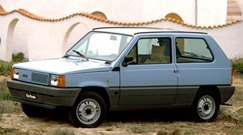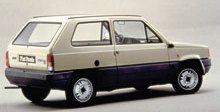Fiat Panda (1980)
 In
my memory Fiat Panda was a cheap little car with nasty build quality
and limited driver appeal. Occupying the bottom end of Fiat's product
range, it was the cheapest of the cheapest, basic of the basic kind of
vehicle. So what made it qualified for our Classic Car Archives ? With
4.5 million units sold in a very long life span of 23 years, it
certainly worth consideration. Another key reason was its trend-setting
"tall-body" design by Giorgetto Giugiaro. In
my memory Fiat Panda was a cheap little car with nasty build quality
and limited driver appeal. Occupying the bottom end of Fiat's product
range, it was the cheapest of the cheapest, basic of the basic kind of
vehicle. So what made it qualified for our Classic Car Archives ? With
4.5 million units sold in a very long life span of 23 years, it
certainly worth consideration. Another key reason was its trend-setting
"tall-body" design by Giorgetto Giugiaro. To maximize interior space, Giugiaro designed the Panda to be boxy and unusually tall – its height matched its width, a profile unbeneficial to handling but gave it so much advantage in space efficiency. This enabled not only a lot of headroom but also a higher seating position, which allowed the passengers to sit more upright thus freed up leg room and foot room. The tall-body design would influence many mini cars from rival manufacturers as well as Fiat's own Uno and Lancia Y10.  As the Panda was the cheapest
car in Europe, everything was designed to save money. Its
folding-paper-like bodyshell was easy to produce. Its flat windscreen
and windows were cheap to source and replace. Its cabin was spartan. It
offered only one body style – 3-door hatchback – and very limited
choices of equipment. It employed non-independent rigid axle suspension
with leaf springs at the rear like commercial vehicles, so handling and
ride was forgettable (even though the leaf springs were replaced by
coil springs from 1986). As cheap cars don't care about performance, it
employed the small push-rod engines from the outgoing Fiat 126 and 127,
i.e., an air-cooled 652cc twin-cylinder engine with merely 30 hp and a
water-cooled 903cc four-cylinder with 45 hp. The major facelift in 1986
brought a much better new generation FIRE engines (34hp 0.75 liter and
a torquey 45hp 1.0 liter), but still no one would get excited with its
performance and handling. As the Panda was the cheapest
car in Europe, everything was designed to save money. Its
folding-paper-like bodyshell was easy to produce. Its flat windscreen
and windows were cheap to source and replace. Its cabin was spartan. It
offered only one body style – 3-door hatchback – and very limited
choices of equipment. It employed non-independent rigid axle suspension
with leaf springs at the rear like commercial vehicles, so handling and
ride was forgettable (even though the leaf springs were replaced by
coil springs from 1986). As cheap cars don't care about performance, it
employed the small push-rod engines from the outgoing Fiat 126 and 127,
i.e., an air-cooled 652cc twin-cylinder engine with merely 30 hp and a
water-cooled 903cc four-cylinder with 45 hp. The major facelift in 1986
brought a much better new generation FIRE engines (34hp 0.75 liter and
a torquey 45hp 1.0 liter), but still no one would get excited with its
performance and handling.However, that didn't matter to the Panda. In many ways, it was a modern Citroen 2CV – designed for the poor and especially those lived in rural area. It was cheap to buy and to maintain. It was economical to run. It offered a folding rear seat which could turn to a large cargo area. Its removable fabrics enabled the cabin to be cleaned easily. It even offered a 4x4 version to deal with country roads. Cheap cars had never been so versatile and clever. |